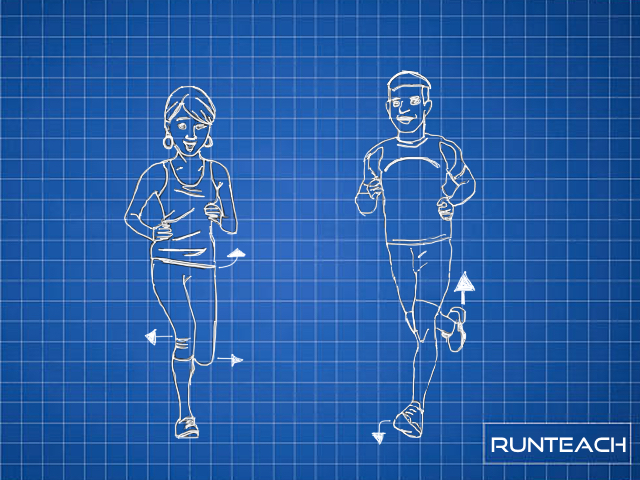Lesson 6 – Running Technique
This post relates to my Blueprint for running, which is free to download here – from my other site, The Confident Runner.
I hope you’ve been enjoying this series of emails, and you are finding them useful.
If you are, could I ask you a favour? Could you please share the emails with your friends and family who you think may benefit from them as well. You can also share my website addresses (TheCondifidentRunner.com and RunTeach.com) so they can subscribe to the email lists and get the updates directly.
Thank you – it will be a huge help as I continue to develop the business and can keep on offering free content. On that note, if there is anything specific you would like me to look into, then just reply and let me know.
OK, today’s email…
In the last email you looked a bit more into the process versus results concept, and why it’s important that:
- You have an end goal to keep you going in the right direction
- Have a backwards plan so can develop the individual processes
- Focus on completing the process so you can more easily achieve the end result so the result will be long-lasting and easier to achieve
Essentially: trust the process. And as long as the process is good enough, it will make your life so much easier.
So how do you apply this to improving your running technique? Let’s have a look…
If you haven’t yet downloaded my free Blueprint for Running from the Confident Runner website, grab a copy now as we’ll be using that to base our example on.
As I mentioned in the last email lesson, changing your running technique can be hard. Sure, you may be able to change it for a short while, but before long you will end up running the way you used to. This can be disheartening and frustrating, especially if you really do want to progress with your running and get better.
For most of us, the reason we find change hard is that we simply don’t have the required skills. And you may be forgiven for thinking that these skills are all physical and beyond your reach; in fact, I often hear people saying things like “I’m just not built for running” or “If only I had longer legs”.
But I’m going to be really hard on you, if you are one of those people, and say to you that these are excuses and it’s a load of rubbish.
Go on YouTube and look at the World’s most successful road runners. Are they all tall with slender long legs? No. Most of them are short or average height. Most of the elite Kenyan women are not much taller than young teenagers. In fact, long legs can be a disadvantage rather than an advantage. So that’s that excuse blown out of the water.
Next, “I’m not built for running”. Complete tosh! If you need proof, then just look at me. I went from definitely not being built for running to losing a load of weight and running a 2 hour 59 minute marathon. I’ve seen examples of people doing the same but achieving 2 hour 30 minute marathons and quicker. So I don’t ever want to hear anyone saying they are not built for running – it boils my blood! You are an athlete, and your brain wants you to act like one.
And this leads me onto the first part of the Blueprint: What are you aiming for?
This is your end result. Looking at the Blueprint, the end result is actually the achievement of all of the markers. And this is a great example of process versus result.
It would be very easy to start working towards one of the markers only to get a bit bored and shift your focus to another marker before making any real progress. And in reality, this is exactly what I see happening. I understand why: getting good running technique is hard. It’s even harder without the right approach.
So, I’m going to assume you are now in a position where you want to make some changes and have pushed your excuses away (we’ll come back to this in a future email). What are the markers of efficient and helpful running technique that you can build your processes around achieving?
- Relaxed, upright posture
- High cycling heels
- Driving from smooth, powerful and stable hips
- Running from the lower body, shaping from the upper body
For me, the most important of these is number 3, Driving from smooth powerful hips. Once you achieve a good level of skill in this area, you will find the other markers much easier to work on.
The hips are so important, it’s actually the first process-specific course that I’ve written – designed to help you create the foundation from which to launch better running technique. You can find out more on The Confident Runner website here.
So going back to process versus result to wrap up, the first goal is find out what you need to improve. As you can see from the four markers above, it could get very complex if just set out to improve each one without any guidance. You’d literally spend hours trawling through books and videos trying things out and making only short term gains.
This is where the processes come in. Luckily, I’ve already done the hours and hours of research and experimenting to formulate the processes for you. The Blueprint is the higher level overview of this.
To get your starting point of what you need to improve, the process is the first two steps of the Blueprint:
- What do you want to achieve?
- Where are you now?
We’ve covered the first step in our four markers above, and the second step is assessing where you are now. The Blueprint contains a self-assessment process that you can use to help you.
The assessment step is the subject of the next email, so between now and then it would be a great idea for you to review the step in the Blueprint.
Best wishes,
Chris
Founder


